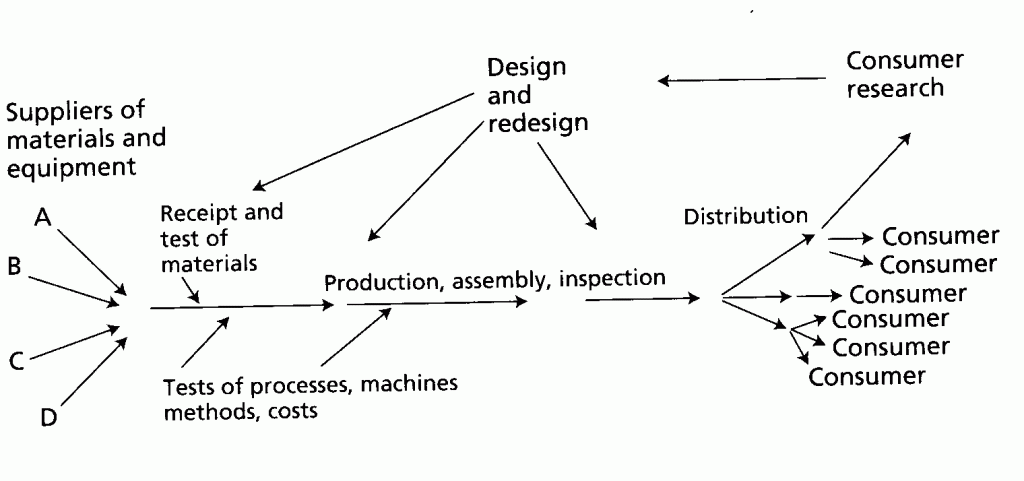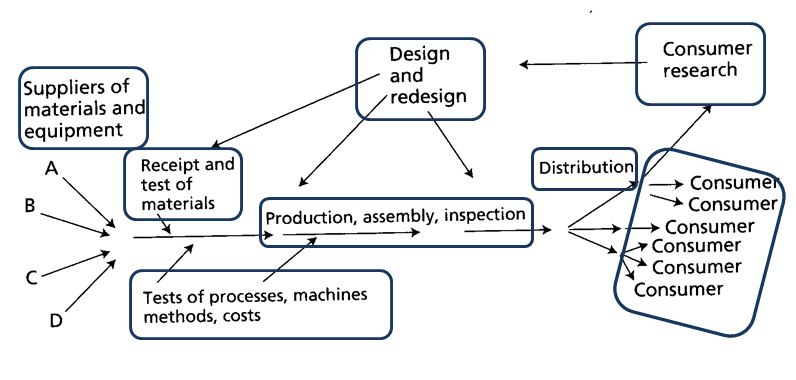What would Dr. Deming Say?
Dr. W. Edwards Deming advised us that a supplier is a partner and our relationships must be based on cooperation and trust. Adversarial relationships result in waste. Supplier relationships based on Dr. Deming’s teachings change fundamentally and, even better, both suppliers and customers win.
Dr. Deming showed how customers and suppliers are brought into, and become part of, the production system. System’s thinking is the key. The supplier-producer-customer network (value stream) works together as a system. The outline he so often used is depicted below.
Dr. Deming would also talk about how we sub-optimize an organization by looking at each component above as an adversarial position. He talked about how each person, plant, supplier, work unit are pitted against each other and have little care for its impact on another part of the unit. When something goes wrong these isolated units strive to protect themselves from blame.
Dr. Deming’s description of a system:
A system is a series of functions or activities within an organization that work together for the aim of the organization.
The components are necessary but not sufficient to accomplish the aim of the system. There is in almost any system inter-dependence between the components thereof. The greater is the interdependence between components, the greater the need for communication and cooperation between them.
The aim, the values and beliefs of the organization, as set forth by top management, are important. The aim of the system must be clear to everyone in the system. Without an aim, there is no system. The performance of any component is to be judged in terms of its contribution to the aim of the system, not for its individual production or profit, nor for any other competitive measures.
If the aim, size, or boundary of the organization changes; the functions of the subcomponents will change for optimization of the new system. Management of a system, therefore, requires knowledge of the interrelationship between all the sub-processes within the system and of everybody that works in it.
Management’s job is to optimize the entire system. Sub-optimization is costly. It would be poor management, for example, to optimize sales, or to optimize manufacture, design of product, or of service, or incoming supplies, to the exclusion of the effect on other stages of production.
-Deming, W. Edwards, Foundation for Management of Quality in the Western World
I would believe that a Lean enterprise or organization follows Dr. Deming’s teachings. It is also why I believe a Lean Enterprise has the best opportunity in this social world. It is the essence of what Dr. Deming has taught us.
Above, I drew a few red lines to show that the social interaction has become a little more complicated than what Dr. Deming first proposed. However, it does not need to be all that complicated. The Value Network maps of Verna Allee that I discussed in a previous blog post, Is Relationship Mapping the new Critical Path?, can make this process much easier.
Example: My preference from a service design or a marketing perspective is to first review my existing value stream. I prefer making it stronger versus trying to add more suppliers and consumers. For example, if I review the tangible and intangible outputs for a given supplier. Are they delivering value at multiple stages of the value stream? Can that value be used in other areas? If I do this, will their value streams strengthen and as a result grow my value stream?
This is not anything more than what Dr. Deming told us:
Management’s job is to optimize the entire system. Sub-optimization is costly. It would be poor management, for example, to optimize sales, or to optimize manufacture, design of product, or of service, or incoming supplies, to the exclusion of the effect on other stages of production
Value streams are anything but linear any more. They are collaborative in nature with overlapping responsibilities. Most of us are not looking at the production process as Dr. Deming addresses, rather we are viewing social collaboration. We are looking at how vendors, customers and others that may even be hard to classify can provide value to our network. In fact, we may have a hard time establishing if they are a customer or vendor.
The Deming Quotes were found in Four Days with Dr. Deming: A Strategy for Modern Methods of Management.
Consider reading: Where does a Customer Find Value in your Organization?




Comments are closed.